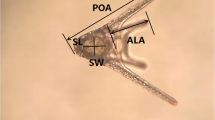Abstract
Select temperatures, above normal, are shown to reduce success of fertilization and normal early cleavage in the laboratory for the echinoderms Acanthaster planci (L.), Culcita novaeguineae Muller and Troschel, Linckia laevigata (L.), Echinometra mathaei (de Blainville), and Diadema savignyi Michelin. The data indicate that cleavage is more sensitive to increased temperature than is fertilization. Upper tolerance limits for early cleavage in most of the species examined is near 34.0°C. The early developmental stages of A. planci were the most sensitive to elevated temperature, and those of E. mathaei, the least sensitive. Further experiments with E. mathaei showed that unfertilized ova were still viable, dividing normally when fertilized after 2 h exposure at 36.0°C. The ova were significantly less viable after 3 h. Early cleavage stages of E. mathaei were resistant to 36.0°C for exposure times of up to 40 min, but were inhibited beyond this period. It is suggested that the ability of E. mathaei to develop normally at 34.0°C (6C° above ambient temperature) and to withstand limited exposure to 36.0°C may account for the wide distribution of this species in habitats which are often subjected to broad temperature fluctuations, such as reef flats.
Similar content being viewed by others
Literature cited
Andronikov, V. B.: Heat-resistance of gametes of poikilothermic animals. In: The cell and environmental temperature, pp 398–402. Ed. by A. S. Troshin. Oxford: Pergamon Press 1967.
Farmanfarmaian, A. and A. C. Giese: Thermal tolerance and acclimation in the western purple sea urchin, Strongylocentrutus purpuratus. Physiol. Zoöl. 36, 237–243 (1963).
Glynn, P. W.: Mass mortalities of echinoids and other reef flat organisms coincident with midday, low water exposure in Puerto Rico. Mar. Biol. 1, 226–243 (1968).
Kanatani, H.: Induction of spawning and oocyte maturation by 1-methyladenine in starfishes. Expl Cell Res. 57, 333–337 (1969).
Kobayashi, N., H. Nogami and K. Doi: Marine pollution bioassay by using sea urchin eggs in the Inland Sea of Japan (the Seto-Naikai). Publs Seto mar. biol. Lab. 19, 359–381 (1972).
Sokal, R. and F. Rohlf: Biometry, 776 pp. San Francisco: W. H. Freeman & Co. 1969.
Tyler, A.: On the energetics of differentiation. III. Comparison of the temperature coefficients for cleavage and later stages in the development of the eggs of some marine animals. Biol. Bull. mar. biol. Lab., Woods Hole 71, 59–81 (1936).
—: A simple, non-injurious, method for inducing repeated spawning of sea urchins and sand dollars. Collecting Net 19, 19–20 (1949).
Author information
Authors and Affiliations
Additional information
Communicated by J. Bunt, Miami
Contribution No. 46 from the University of Guam Marine Laboratory.
Rights and permissions
About this article
Cite this article
Rupp, J.H. Effects of temperature on fertilization and early cleavage of some tropical echinoderms, with emphasis on Echinometra mathaei . Mar. Biol. 23, 183–189 (1973). https://doi.org/10.1007/BF00389483
Accepted:
Issue Date:
DOI: https://doi.org/10.1007/BF00389483




